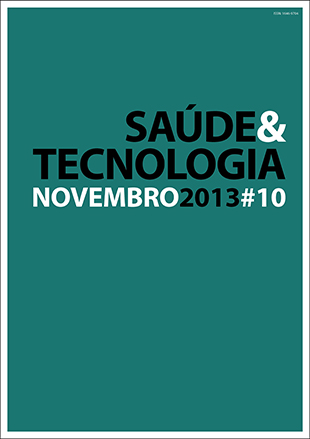Assessment of the effective dose received by the radiographer at the occupational context
DOI:
https://doi.org/10.25758/set.674Keywords:
Effective dose, Radiographer, Occupational exposure, Ionizing radiationAbstract
Introduction – As part of its work, the Radiographer is exposed to ionizing radiation and subjected to its potential biological effects. Materials and methods – In order to evaluate the effective dose received by the Radiographer in the different radiological methods it was undertaken an exploratory and descriptive study. Measurements were carried out using thermoluminescent dosimeters in five different radiological methods. Questionnaires were administered to Radiographers, to determine the total work hours and the general measures of radiological protection used during the measurement period. Results – It was found that the effective doses, calculated per hour, were higher in Intervention Radiology, with data obtained over the lead protection, and Mammography showed the lowest effective dose calculated per hour Mammography, presenting a measurement value equal to zero. Conclusions – Differences were detected in the received effective dose according to the function performed by the Radiographer. Values of effective dose for one year, calculated by extrapolation, showed that the values corresponding to each method are well below the annual legal limit of 20mSv.
Downloads
References
Ministério da Saúde. Decreto-Lei nº 564/99, de 21 de dezembro. Diário da República. 1999 Dez 21;I Série-A:9083-100.
Oliveira JC, Martinho E. Energia nuclear: mitos e realidades. Santarém: O Mirante Editora; 2000. ISBN 9728585055
Leite ES, Uva AS, Serranheira F. Exposição a radiações ionizantes em cirurgia ortopédica num hospital público de Lisboa [Orthopaedic surgeries: assessment of ionising radiation exposure in health care workers]. Rev Port Saúde Pública [Internet]. 2006 [cited 2012 Oct 15];6(temático):55-66. Available from: http://www.ensp.unl.pt/dispositivos-de-apoio/cdi/cdi/sector-de-publicacoes/revista/2000-2008/pdfs/e-05-2006.pdf. Portuguese
Lombardi MH. Radiation safety in nuclear medicine. New York: CRC Press; 2000. ISBN 9780849318979
Scremin SC, Schellin HR, Tilly Jr, JG. Avaliação da exposição ocupacional em procedimentos de hemodinâmica [Evaluation of occupational exposure in hemodynamic procedures]. Radiol Bras [Internet]. 2006 [cited 2012 Oct 15];39(2):123-6. Available from: http://www.scielo.br/pdf/rb/v39n2/29194.pdf . Portuguese
Pinto I, Schiappa J, Parafita R, Carvoeiras P, Martins B, Trindade H, et al. Avaliação da exposição radiológica dos profissionais de saúde [Health professionals radiological exposure evaluation] [Internet]. Medical Consult; 2008 [cited 2013 Jan 30]. Available from: http://www.medicalconsult.pt/useruploads/files/avaliacaoexposicaoradiologicaprofissionaissaudesppcr.pdf. Portuguese
Ministério da Saúde. Decreto-Lei nº 222/2008, de 19 de novembro. Diário da República. 2008 Nov 17;I Série(223):8000-76.
Baquero Pulido H, Guevara Pardo G, Giraldo Suárez M, Osorio Soto LM. Aberraciones cromossómicas en trabajadores expuestos a radioaciones ionizantes. Rev Ciências Salud [Internet]. 2004 [cited Oct 15];2(1):8-14. Available from: http://redalyc.uaemex.mx/pdf/562/56220102.pdf. Spanish
Ferreira HR. Percepção de risco e otimização da radioproteção na área de saúde [Internet]. Associação Brasileira de Física Médica; 2004 [cited 2012 Oct 15]. Available from: http://www.abfm.org.br/c2004/trabalhos/weos76.pdf. Portuguese
Dimenstein R, Hornos YM. Manual de proteção radiológica aplicada ao radiodiagnóstico. S. Paulo: Senac; 2001. ISBN 8573591919
Sherer MA, Visconti PJ, Ritenour ER. Radiation protection in medical radiography. 2nd ed. St. Louis: Mosby; 2002. ISBN 081657504
Järvinen H, Buls N, Clerinx P, Jansen J, Miljanic S, Nikodemová D, et al. Overview of double dosimetry procedures for the determination of the effective dose to the interventional radiology staff. Radiat Prot Dosimetry. 2008;129(1-3):333-9.
Toschi LF, Nunes AL. Análise das doses individuais dos profissionais do serviço de radiologia de um grande complexo hospitalar de Porto Alegre [Internet]. Associação Brasileira de Física Médica; 2004 [cited 2012 Oct 15]. Available from: http://www.abfm.org.br/c2004/trabalhos/wepo3w01.pdf. Portuguese
Gronchi CC, Furnari L, Cecatti SG, Campos LL. Controle da exposição ocupacional às radiações ionizantes nos serviços de hemodinâmica segundo Portaria 453 e American College of Cardiology. Associação Brasileira de Física Médica; 2004 [cited 2012 Oct 15]. Available from: http://www.abfm.org.br/c2004/trabalhos/wepo315.pdf. Portuguese
Oliveira SR, Azevedo AC, Carvalho AC. Elaboração de um programa de monitoração ocupacional em radiologia para o Hospital Universitário Clementino Fraga Filho [Implementation of an occupational monitoring program in diagnostic radiology at the "Hospital Universitário Clementino Fraga Filho”]. Radiol Bras [Internet]. 2003 [cited 2012 Oct 15];36(1):27-34. Available from: http://www.scielo.br/pdf/rb/v36n1/15168.pdf. Portuguese
Almeida C, Arede E, Costa S, Vieira S. Mamografia: overview. TDT Online Magazine [Internet]. 2008 Nov/Dez [cited 2013 Jan 30]; 14-8. Available from: http://www.tdtonline.org/articles.php?id=magazine&sid=379f4441d30c2432eb6cec11de58ea4a. Portuguese
EBAH. Curso de biossegurança – Cap. 7: métodos radiográficos especiais [Internet]. Arquivo Curso Biomedicina Universidade Federal do Piauí; 2011 [cited 2013 Jan 30]. Available from: http://www.ebah.com.br/content/ABAAABg3wAC/metodos-radiograficos-especiais. Portuguese
Schauer DA, Linton OW. National Council on Radiation Protection and Measurements report shows substantial medical exposure increase. Radiology. 2009;253(2):293-6.
Singh S, Kalra MK, Thrall JH, Mahesh M. CT radiation dose reduction by modifying primary factors. J Am Coll Radiol. 2011;8(5):369-72.
Downloads
Published
Issue
Section
License
Copyright (c) 2013 Saúde e Tecnologia

This work is licensed under a Creative Commons Attribution-NonCommercial-NoDerivatives 4.0 International License.
The journal Saúde & Tecnologia offers immediate free access to its content, following the principle that making scientific knowledge available to the public free of charge provides greater worldwide democratization of knowledge.
The journal Saúde & Tecnologia does not charge authors any submission or article processing charges (APC).
All content is licensed under a Creative Commons CC-BY-NC-ND license. Authors have the right to: reproduce their work in physical or digital form for personal, professional, or teaching use, but not for commercial use (including the sale of the right to access the article); deposit on their website, that of their institution or in a repository an exact copy in electronic format of the article published by Saúde & Tecnologia, provided that reference is made to its publication in Saúde & Tecnologia and its content (including symbols identifying the journal) is not altered; publish in a book of which they are authors or editors the total or partial content of the manuscript, provided that reference is made to its publication in Saúde & Tecnologia.







